The Western US has long been an innovator in developing the urban form, notably in the creation of suburbanized, multipolar cities. Yet now that model is showing strain, and there’s a fierce debate about how western cities should grow. The panel will explore these issues, from homelessness to high housing prices and the impact of regulation.
With an all star lineup including:
Charles Blain- Urban Reform Institute
Karla López del Río- Community Development Professional
Ryan Streeter- State Farm James Q. Wilson Scholar
Natalie Gochnour- Associate Dean in the David Eccles School of Business
Joel Kotkin- Presidential Fellow in Urban Future, Feudal Future Podcast Host
Watch the video:
This event was moderated by Henrik Cronqvist and panelists discussed how the Western US, a long-time innovator in developing the urban form, is now experiencing issues from homelessness to high housing prices and the impact of regulation.
The California Dream:
From Chapman's Center of Demographics & Policy, Joel Kotkin & Marshall Toplansky co-author the brand new report on restoring The California Dream.
If you haven't downloaded the report, see it here:
Restoring the California Dream
Visit Our Page
www.TheFeudalFuturePodcast.com
Support Our Work
The Center for Demographics and Policy focuses on research and analysis of global, national, and regional demographic trends and explores policies that might produce favorable demographic results over time. It involves Chapman students in demographic research under the supervision of the Center’s senior staff.
Students work with the Center’s director and engage in research that will serve them well as they look to develop their careers in business, the social sciences, and the arts. Students also have access to our advisory board, which includes distinguished Chapman faculty and major demographic scholars from across the country and the world.
For additional information, please contact Mahnaz Asghari, sponsored project analyst for the Office of Research, at (714) 744-7635 or asghari@chapman.edu.
Follow us on LinkedIn
Tweet thoughts: @joelkotkin, @mtoplansky, #FeudalFuture #BeyondFeudalism
Learn more about Joel's book The Coming of Neo-Feudalism
Sign Up For News & Alerts: joelkotkin.com
This show is presented by the Chapman Center for Demographics and Policy, which focuses on research and analysis of global, national and regional demographic trends and explores policies that might produce favorable demographic results over time.














